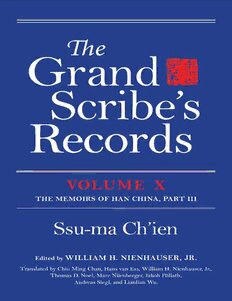
The Grand Scribe's Records, vol. X: 10: Volume X: The Memoirs of Han China, Part III PDF
Preview The Grand Scribe's Records, vol. X: 10: Volume X: The Memoirs of Han China, Part III
The Grand Scribe’s Records VOLUME X The Memoirs of Han China, Part III The Grand Scribe’s Records VOLUME X The Memoirs of Han China, Part III by Ssu-ma Ch’ien William H. Nienhauser, Jr. Editor Chiu Ming Chan, Hans van Ess, William H. Nienhauser, Jr., Thomas D. Noel, Marc Nürnberger, Jakob Pöllath, Andreas Siegl, and Lianlian Wu Translators IINNDDIIAANNAA UUNNIIVVEERRSSIITTYY PPRREESSSS NANJING UNIVERSITY PRESS This book is a copublication of Indiana University Press Office of Scholarly Publishing Herman B Wells Library 350 1320 East 10th Street Bloomington, Indiana 47405 USA iupress.indiana.edu and Nanjing University Press 22 Hankou Road Nanjing, Jiangsu, China © 2016 by William H. Nienhauser, Jr. © 2020 by William H. Nienhauser, Jr. All rights reserved No part of this book may be reproduced or utilized in any form or by any means, electronic or mechanical, including photocopying and recording, or by any information storage and retrieval system, without permission in writing from the publisher. The paper used in this publication meets the minimum requirements of the American National Standard for Information Sciences—Permanence of Paper for Printed Library Materials, ANSI Z39.48-1992. Manufactured in the United States of America Originally cataloged by the Library of Congress (and revised for volume 7 [1994]) as Ssu-ma Ch’ien, ca. 145–ca. 86 B.C. The grand scribe’s records. Includes bibliographical references and index. Contents: v. 1. The basic annals of pre-Han China — v. 2. The basic annals of Han China v. 7. The memoirs of pre-Han China. 1. China—History—To 221 B.C. 2. China—History—Ch’in dynasty, 221- 207 B.C. 3. China—History—Han dynasty 202 B.C.-220 A.D. I. Nienhauser, William H. II. Cheng, Tsai Fa. III. Title. DS741.3.S6813 1994 931—dc20 094-18408 ISBN 0-253-34021-7 (v. 1) ISBN 0-253-34027-6 (v. 7) ISBN 978-0-253-01931-8 (hdbk.) ISBN 978-0-253-02069-7 (web PDF) 1 2 3 4 5 25 24 23 22 21 20 DEDICATED TO THREE OF MY FIRST TEACHERS Lillian Stolle Nienhauser, Julie Harding Brown, and Nancy Brown Nienhauser CONTENTS Acknowledgments ix Introduction xiii On Using This Book xvii Weights and Measures (Lu Zongli) xix List of Abbreviations xxiv Memoir 53 “The Southern Yüeh (William H. Nienhauser, Jr., transl.) 1 Memoir 54 “The Eastern Yüeh” (William H. Nienhauser, Jr. transl.) 29 Memoir 55 “Ch’ao-hsien” (Chao Ming Chan and Nienhauser, transl.) 47 Memoir 56 “The Southwestern Barbarians” (Thomas D. Noel and Lianlian Wu, transl.) 65 Memoir 57 “Ssu-ma Hsiang-ju” (Hans van Ess, transl.) 83 Memoir 58 “Huai-nan and Heng-shan” (Marc Nürnberger, transl.) 161 Memoir 59 “The Officials Who Follow Reason” (Nienhauser, transl.) 227 Memoir 60 “Chi and Cheng” (Jakob Pöllath and Andreas Siegl, transl.) 245 Memoir 61 “The Confucian Scholars” (Nienhauser et al. transl.) 267 Frequently Mentioned Commentators 313 Selected Recent Studies of the Shih chi 317 Index 321 vii Acknowledgments In the past nearly twenty-five years I’ve been reading the Shih chi with some regularity, often with large groups of other students of the Shih chi. It has been a memorable experience which has allowed me to meet with a number of scholars with similar interests around the world. Strangely, as I read more of the text carefully, I become less sure of things. This transformation made poignant recent comments by the centarian M. H. Abrams: The world of the prophet is a hot, intense world of total assurance that you have the humanistic truth that you know what we must do to be saved‒and as such, it has great contemporary appeal. In comparison with the hot world of prophecy, the world of the liberal humanist is a cool world. What we need to get our students to recognize is that the stance of the liberal humanist is a very difficult one, which takes poise and courage to maintain.”1 The title for our translations could have been changed to Grand Scribes’ Records [from Grand Scribe’s Records] to reflect evolving ideas about the authorship of the Shih chi. This current assumption might be best summed up by citing Hans van Ess: I am fully aware that his father Sima Tan must have written large parts of the Shiji . . . There are good reasons to believe that some chapters of the Shiji as we have them today go back to Sima Tan. . . .Yet I do not believe that is it possible to divide the Shiji into one part that was written by Sima Qian and one that derives from the hand of Sima Tan . . . I share Zhang Dake’s view (Shiji yanjiu ) . . . that the Shiji in the end was finished by Sima Qian and that, should there really have been major differences between his father’s views and his own, we cannot say very much about them for sure today . . . For these reasons, whenever Sima Qian is mentioned . . . he is seen as the final editor of the Shiji whose ideas we can analyze today.”2 The chapters in this volume have been produced and revised in various venues by a host of scholars. I am grateful to all for their effort, their knowledge, and their 1 Cited from Vidyan Ravinthiran’s review of Abrams The Fourth Dimension of a Poem (New York: Norton, 2012), Times Literary Supplement 24 May 2013: 12. 2 See van Ess, “Cosmological Speculations and the Notions of the Power of Heaven and the Cyclical Movements of History in the Historiography of the Shiji,” BMFEA 78 (2006). 79 [79–107], n. 2. See also my own statements on the authorship question in Grand Scribes’ Records, 5.1 (Bloomington: Indiana University Press, 2006), xviii–xix), Grand Scribes’ Records, 8 (2008), p. ix and n. 3, and especially “Sima Qian and the Shiji,” Oxford History of Historical Writing, Volume I: Beginnings to AD 600. Grant Hardy and Andrew Feldherr, eds. (Oxford: Oxford University Press, 2011), p. 474. ix
